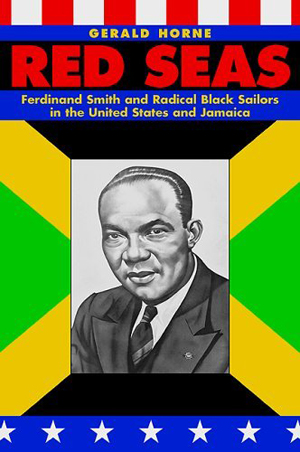Red Seas: Ferdinand Smith and Radical Black Sailors in the United States and Jamaica. By Gerald Horne. New York University Press, 2005, 358 pp.
The political connections of Harlem and the British West Indies have been crucial for at least a century, but until recent times almost invisible except to those intimately involved. Documentation has been slow and difficult, due in no small part to the need for left-wing activists to stay as anonymous as possible as they sought to evade both colonial authorities and the FBI. We are now, at last, beginning to get a better grasp, and Gerald Horne‘s Red Seas is a huge contribution to our understanding.
First, a little context. Marcus Garvey was, of course, Jamaican and his move to Harlem in the mid-1910s a symbolic shift of operation for black nationalists, only some of them Caribbean in origin. Theodore Draper, not a sympathizer, noted the prominent role played by West Indians in the early Communist party’s orientation toward African Americans. The African Blood Brotherhood as much as dissolved into the Communist milieu, with Cyril Briggs, Hubert Harrison, and others from the islands — veterans of Briggs’ magazine, The Crusader — at the left edge of Garveyism and much in the eye of Moscow. Less understood has been the role of left-wingers who returned to the Caribbean.
Wilfred Domingo, himself never quite a Communist, has been the best-known example, because his return to Jamaica in 1938 coincided with the development of a Marxist-oriented Left within the framework of Norman Manley‘s nationalist movement. Others, less remembered, found their own way back to Trinidad, Antigua, and an assortment of British colonies in the region, instigating or taking part in the movements that the strike waves of the 1930s carried toward independence struggles.
Gerald Horne has given us the fullest story of any returnee, all the more important because his subject, Ferdinand “Ferdy” Smith, achieved a unique status in the American labor movement. The IWW’s influence in the port of Philadelphia was the fading organization’s lasting imprint on the lives of a multiracial seafaring workforce. It might be said that Smith took up where the Wobblies left off.
Smith was there at the birth of the National Maritime Union in 1937, after working undercover, so to speak, with an earlier craft union for several years. He was not the only Communist in the leadership, by a long shot, but he was prominent for being black and endangered by the lack of US citizenship. In retrospect, he was always living on borrowed time.
But Pearl Harbor brought a unique situation to labor relations in several ways. Communists found themselves enforcing contracts. But they also jumped at the opportunity as no one else in the American labor movement did to integrate the workforce and to break down the racial barriers at various levels of union activity. Not a single non-white activist in all labor, perhaps all across Europe and North America, had such a high profile as Smith, and no one worked harder to open doors. From his office at NMU headquarters in New York, he worked closely with the National Negro Congress, the Southern Negro Youth Congress, and the Southern Conference on Human Welfare, all closely associated with the Communist milieux.
The net effect of these institutions in preparing the ground for the great civil rights to come has rarely been understood (liberal historians have been more staunch than conservatives in their denial of it, for the most obvious reasons). Horne, author of the definitive study of the Civil Rights Congress, understands the significance better than anyone else could.
Of course, J. Edgar Hoover was on the case, and, like anticommunists in the labor movement (including the organized Catholic entity, the Association of Catholic Trade Unionists, at first progressive, then compellingly reactionary), sprang the trap at the first opportunity to expel them utterly. NMU leader Joseph Curran would prove cooperative. (NMU cartoonist once Fred Wright told me that he’d been ordered personally by Curran to depict Communist as rats; he chose to leave the NMU for the United Electrical Workers, where he visually held court for decades.) The loss for American black unionists was monumental.
This was not the end of the story for Smith, as it was for many left-wing unionists, because he could return to Jamaica. There, in 1951, he was simultaneously the most famous and notorious unionist on the island. Had he stayed, he might have established himself as a pillar of the nationalist movement . . . and still faced expulsion from the political machine that Norman Manley had built and then found threatened by American political pressure to get into line on the US side of the Cold War.
My only difference with Horne, and it is a slight one, rests in the depiction of budding Jamaican nationalism. Others on the same leftward edge, faced with the same repression, evidenced somewhat more sympathy for Manley, and for the next Manley even more so. Ironically, Michael Manley would be compelled to rebuild what the elder Manley had destroyed, a labor left on the island among the most oppressed workers. Horne is understandably bitter because Ferdinand Smith’s bold efforts were utterly smashed, Smith himself made a pariah. In return, Smith (like many African Americans who chose to remain in the Communist movement after the divisions of 1956) was a hard-line supporter of the Soviet Union. Persecuted to the end, forbidden to leave Jamaica as he had been driven from the US, Smith remained a staunch revolutionary to his dying day in 1961. He was a giant, long forgotten, now, thanks to Horne, remembered at last.


